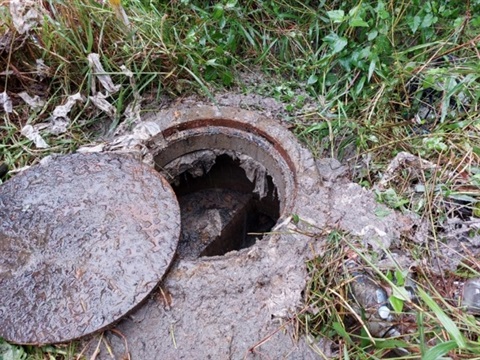What can I flush away?

Blockages, flushability and the Four Ps
Like your household plumbing, our sewer system can sometimes block up. Sometimes this happens naturally, but often these blockages are at least partly caused by people flushing the wrong things down the toilet – things like wet wipes, rags or other personal hygiene products.
When our sewer mains block up, the only place left for the sewage to go is out. And with millions of litres of wastewater being created across our network every day, even a relatively small blockage can easily cause thousands of litres of contaminated water to overflow from our system. The above photo shows the mess of poo and wet wipes that overflowed from one of our sewer manholes after a clump of wet wipes blocked the pipe.
Besides smelling awful, sewer overflows can have serious impacts on both public and environmental health. Raw sewage can spread disease to people who come into contact with it, and can also pollute waterways with chemical and biological pollutants.
Our sewer maintenance team is committed to getting things cleaned up and moving again whenever our sewer mains block up, but we need your help to prevent blockages in the first place.
You can do your part by being careful to only flush the Four Ps down the toilet:




Pee
Pour the rain down the drain
Urine may not seem like much, but in terms of sewer compatibility, it’s just about as special as a liquid can be. Unlike fats, oils and grease, pee doesn’t thicken or solidify in our pipes, so it will never cause a blockage. It also doesn’t react with our sewer pipes and won’t kill the bacteria that power our sewage treatment plants. It’s no wonder they call it No# 1.
Poo
If it’s brown, flush it down
You might expect that, like most other solids, poo can block up our sewer. Surprisingly, this isn’t the case. The forces of being flushed down a toilet and washed through our sewer pipes are usually enough to beat your poop to a pulp. By the time it reaches one of our treatment plants, all that remains is brown-coloured toilet water. It’s not a pretty sight, but at least it’s not going to cause any blockages.
Toilet Paper
Paper from the roll is safe in the bowl
Have you ever noticed tiny pieces of toilet paper floating in the bowl after you flush? If so, you’ve witnessed the incredible engineering of toilet paper at work. Most paper products (including most tissues, paper towels and wet wipes) tend to clump together when wet. This creates a soggy lump which can clog up our sewer pipes. Toilet paper, on the other hand, is specifically designed to break apart when flushed. This lets toilet paper pass through our sewer without causing any blockages.
Proven items
For everything else, it’s logo or no-go

For a long time, pee, poo and toilet paper were the only things we knew for certain to be safe to flush away. Over time, some manufacturers began to use words like “flushable” to advertise other products, despite that fact that some of these products were known to block the sewer. This caused a lot of confusion about what can be safely flushed away.
To help settle the flushable debate once and for all, Standards Australia have recently developed AS/NZS 5328:2022. This is a world-leading standard for testing whether a product is safe to flush down a toilet. Products that have been proven to meet all of this standard’s requirements are safe to flush and will have a new flushable logo on their packaging. Keep an eye out for this logo next time you visit the supermarket, as some new products have already been developed that meet all of the standard’s requirements.
At the end of the day, if it isn’t pee, poo or toilet paper and if there isn’t a flushable logo on its packaging, please dispose of it in the bin and not in the toilet.
Resources
To help you with helping us prevent sewer blockages and overflows, we have developed a downloadable Four Ps poster. Feel free to hang this poster in your bathroom to remind you and your guests of what can safely be flushed down the toilet, and what should be put in a bin.
Download the Four Ps poster(PDF, 179KB)
There are also free copies of this poster available at the following locations:
Lismore
- LCC Goonellabah Corporate Centre
- Goonellabah Library
- Lismore Pop-Up Library
- Lismore Children’s Library
- Lismore Revolve Shop
Nimbin
- Nimbin Waste Transfer Station
- Nimbin Post Office
- Nimbin Neighbourhood & Information Centre
For more information on AS/NZS 5328:2022, please refer to Standards Australia or the Water Services Association of Australia (WSAA).